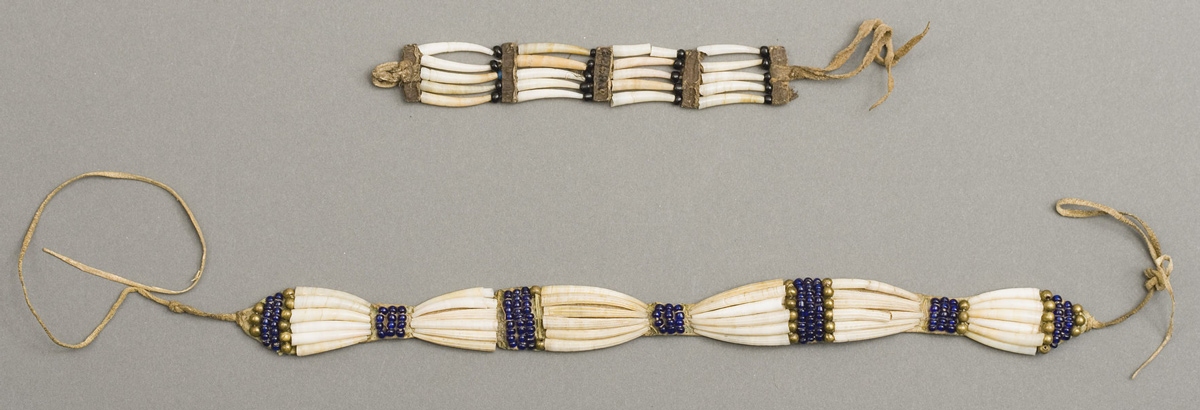The captains work in St. Louis while the enlisted men at Camp River Dubois follow Sgt. Ordway‘s orders. In an undated note, Clark informs Lewis that he can’t find the hair pipes purchased as Indian gifts.
At St. Louis
Sundy, mon: & Tuesday, at St Louis
—William Clark
Missing Hair Pipes
[April 1804]
Memorandom of Artecles which may be wanting
. . . .
I can’t find Hair Pipes purchased of Mr. Chouteau. Mr. Hays says they are necessary. Perhaps you may since have found them. Those purchased are not to be found here.[1]Clark to Lewis. Written in Clark’s hand with Lewis’s responses set here in italics. Donald Jackson, ed. Letters of the Lewis and Clark Expedition with Related Documents: 1783-1854, 2nd … Continue reading
Bracelet and Choker
Plateau c. 1875–1900
Courtesy U.S. National Park Service, Nez Perce National Historical Park, NEPE 2194 and NEPE 8762.
Text accompanying this photo:
The waw·qíaqt or choker [bottom] is from the Rydryck Collection, combines dentalia shells, blue glass beads and brass beads sewn onto a single piece of leather with buckskin ties. The bracelet … is from the Spalding-Allen Collection combines dentalia shells, black pony beads and leather spacers with buckskin ties. It is assembled with sinew.
Hair pipes were made from shells or bones and used to make chokers, bracelets, and breast plates. At the time of the Lewis and Clark Expedition they were a sign of wealth.
Weather Diary
Thermometr. at rise
Weather Wind at Sunrise Thermometr. at 4 oClock Weather Wind at 4 oClock River 30 above [0] fair N. W. 71 above fair W fall 1 inch —Meriwether Lewis[2]To assist the reader, the editor of this web page has omitted the date column, merged the “River” columns, and spelled out some abbreviations.
Experience the Lewis and Clark Trail
The Lewis and Clark Trail Experience—our sister site at lewisandclark.travel—connects the world to people and places on the Lewis and Clark Trail.
Plan a trip related to April 23, 1804:

Winter Camp at Wood River (Camp Dubois) is a High Potential Historic Site along the Lewis and Clark National Historic Trail managed by the U.S. National Park Service. The site, near Hartford, Illinois, is managed as Lewis and Clark State Historic Site and is open to the public.
In present St. Louis, the Jefferson National Expansion Memorial “commemorates Thomas Jefferson’s vision of the continental expansion of the United States” and is a High Potential Historic Site along the Lewis and Clark National Historic Trail managed by the U.S. National Park Service.
Notes
| ↑1 | Clark to Lewis. Written in Clark’s hand with Lewis’s responses set here in italics. Donald Jackson, ed. Letters of the Lewis and Clark Expedition with Related Documents: 1783-1854, 2nd ed. Urbana: University of Illinois Press, 1978), 175. |
|---|---|
| ↑2 | To assist the reader, the editor of this web page has omitted the date column, merged the “River” columns, and spelled out some abbreviations. |



